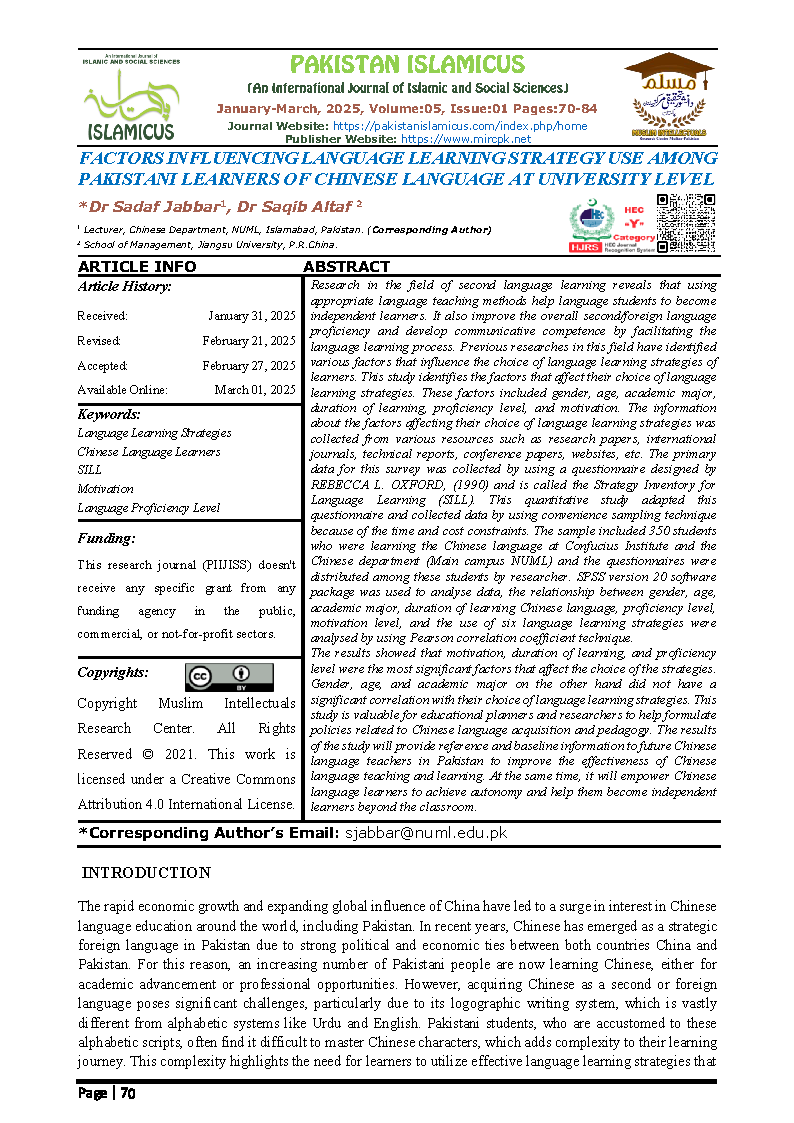FACTORS INFLUENCING LANGUAGE LEARNING STRATEGY USE AMONG PAKISTANI LEARNERS OF CHINESE LANGUAGE AT UNIVERSITY LEVEL
Keywords:
Language Learning Strategies, Chinese Language Learners, Sill, Motivation, Language Proficiency Level.Abstract
Research in the field of second language learning reveals that using appropriate language teaching methods help language students to become independent learners. It also improve the overall second/foreign language proficiency and develop communicative competence by facilitating the language learning process. Previous researches in this field have identified various factors that influence the choice of language learning strategies of learners. This study identifies the factors that affect their choice of language learning strategies. These factors included gender, age, academic major, duration of learning, proficiency level, and motivation. The information about the factors affecting their choice of language learning strategies was collected from various resources such as research papers, international journals, technical reports, conference papers, websites, etc. The primary data for this survey was collected by using a questionnaire designed by REBECCA L. OXFORD, (1990) and is called the Strategy Inventory for Language Learning (SILL). This quantitative study adapted this questionnaire and collected data by using convenience sampling technique because of the time and cost constraints. The sample included 350 students who were learning the Chinese language at Confucius Institute and the Chinese department (Main campus NUML) and the questionnaires were distributed among these students by researcher. SPSS version 20 software package was used to analyse data, the relationship between gender, age, academic major, duration of learning Chinese language, proficiency level, motivation level, and the use of six language learning strategies were analysed by using Pearson correlation coefficient technique.
The results showed that motivation, duration of learning, and proficiency level were the most significant factors that affect the choice of the strategies. Gender, age, and academic major on the other hand did not have a significant correlation with their choice of language learning strategies. This study is valuable for educational planners and researchers to help formulate policies related to Chinese language acquisition and pedagogy. The results of the study will provide reference and baseline information to future Chinese language teachers in Pakistan to improve the effectiveness of Chinese language teaching and learning. At the same time, it will empower Chinese language learners to achieve autonomy and help them become independent learners beyond the classroom.
References
Al-Buainain, H. (2010). Language learning strategies employed by English majors at Qatar University: Questions and queries. Journal of English Language and Literature, 4(2), 92-120.
Ardasheva, Y., & Tretter, T. R. (2013). Strategy Inventory for Language Learning–ELL Student Form: Testing for factorial validity. The Modern Language Journal, 97(2), 474–489. http://dx.doi.org/10.1111/j.1540-4781.2013.12011.x
Bachman, L.F. and A.S. Palmer. 1996. Language testing in practice. New York: Oxford University Press.
Benson, P. and P. Voller (eds.). 1997. Autonomy and independence in language learning. London: Longman.
Bialystok, E. 1978. A theoretical model of second language learning. Language Learning, 28, pp. 69–83.
Bruen, J. (2001). Strategies for success: Profiling the effective learner of German. Foreign Language Annals, 34(3), 216–225.
Canale, M. and M. Swain. 1980. Theoretical bases of communicative approaches to second language teaching and testing. Applied Linguistics, 1, pp. 1–47.
Chamot, A., O’Malley, J., Kupper, L., & Impink-Hernandez, M. (1987). Study of learning strategies in foreign language instruction: First year report. Rosslyn, Va.: Interstate Research Associates.
Chen, M. L. (2014). Age differences in the use of language learning strategies. English language teaching, 7(2), 144-151.
Devlina, M. (1996). Older and Wiser? A comparison of the learning and study strategies of mature age and younger teacher education students. Higher Education Research & Development, 15(1), 51-60.
Dörnyei, Z., & Clément, R. (2001). Motivational characteristics of learning different target languages: Results of a nationwide survey. Motivation and second language acquisition, 23(3), 399-432.
Dreyer, C and R L Oxford 1996. Learning strategies and other predictors of ESL proficiency among Afrikaans speakers in South Africa. In R L Oxford (ed). Language learning strategies around the world: Cross-cultural perspectives. Honolulu: Second Language Teaching and Curriculum Center, University ofHawai'i at Manoa
Ehrman, M., & Oxford, R. L. (1989). Effect of sex differences, career choice, and logical type on adults’ language learning strategies. The Modern Language Journal, 73, 1-13.
Ellis, R. (1990). Understanding Second Language Acquisition. Oxford: Oxford University Press.
Gardner, R.C. 1985. Social psychology and second language learning: The role of attitudes and motivation. London: Edward Arnold.
Goh, C., and Kwah, P. 1997. Chinese ESL students' learning strategies: A look at frequency, proficiency and gender. Hong Kong Journal of Applied Linguistics, 2, 39-53.
Green, J. M., & Oxford, R. (1995). A closer look at learning strategies, L2 proficiency, and gender. TESOL Quarterly, 29(2), 261–297.
Griffiths, C. (2003). Patterns of language learning strategy use. System, 31(3), 367-383.
Griffiths, C., & Oxford, R. L. (2014). The twenty-first century landscape of language learning strategies: Introduction to this special issue. System, 43, 1-10.
Gu, Y. (2002). Gender, academic major, and vocabulary learning strategies of Chinese EFL learners. RELC Journal, 33, 35-54.
Kaylani, C. (1996), The influence of gender and motivation of EFL learning strategy use in Jordan. In R. Oxford, (ed.) Language Learning Strategies Around the World: Cross-cultural perspectives (pp. 75-88). Honololu: University of Hawai'i: Second Language Teaching and Curriculum Center.
Kazamia V. (2003). Language learning strategies of Greek adult learners of English. Unpublished doctoral dissertation. The University of Leeds, United Kingdom.
Khalil, A. (2005). Assessment of language learning strategies used by Palestinian EFL learners. Foreign language annals, 38(1), 108-117.
Lan, R., & Oxford, R. L. (2003). Language learning strategy profiles of elementary school students in Taiwan. IRAL, 41, 339-379. http://dx.doi.org/10.1515/iral.2003.016
Lee, K. R., & Oxford, R. (2008). Understanding EFL learners’ strategy use and strategy awareness. Asian EFL Journal, 10(1), 7-32.
Leung, Y. B. (2011). Language learning strategy of Hong Kong Putonghua learners. Educational Research Journal, 26(1), 17-39.
Larsen-Freeman, D., and Long, M. 1991. An introduction to second language acquisition research. Oxford: Oxford University Press.
Maccoby, E.E & Jacklin, C.N. (1974). The psychology of sex differences. Stanford: Stanford University Press.
Magno, C. (2010). Korean students ‘language learning strategies and years of studying English as predictors of proficiency in English. Teaching English to Speakers of Languages Journal, 2, 39-61.
Ok, L. K. (2003). The relationship of school year, sex and proficiency on the use of learning strategies in learning English of Korean junior high school students. Asian EFL Journal, 5(3), 1-36.
O’Malley, J. M., Chamot, A. U., Stewner‐Manzanares, G., Kupper, L., & Russo, R. P. (1985). Learning strategies used by beginning and intermediate ESL students. Language learning, 35(1), 21-46. http://dx.doi.org/10.1111/j.1467-1770.1985.tb01013.x
Oxford, R. 1990. Language learning strategies: What every teacher should know. Boston: Heinle & Heinle.
Oxford, R. L. (1996). (Ed.) Language learning strategies around the world: Crosscultural perspectives. Honolulu, HI: University of Hawaii Press.
Oxford, R. L., & Burry-Stock, J. A. (1995). Assessing the use of language learning strategies worldwide with the ESL/EFL version of the Strategy Inventory for Language Learning. System, 23(2) 153–175.
Oxford, R.L., and Ehrman, M.E, and Nyikos, M. 1988. Vive la difference? Reflections on sex differences in use of language learning strategies. Foreign Language Annuals, 24/4, 321-329.
Oxford, R. and M. Nyikos. 1989. Variables affecting choice of language learning strategies by university students. Modern Language Journal, 73, pp. 291–300.
Oxford, R. L., &Ehrman, M. E. (1995). Adults’ language learning strategies in an intensive foreign language program in the United States. System, 23(3), 359-386. http://dx.doi.org/10.1016/0346-251X(95)00023-D
Oxford, R. and M. Ehrman. 1995. Adults, language learning strategies in an intensive foreign language program in the United States. System, 23, pp. 359–386.
Peacock, M. and B. Ho. 2003. Student language learning strategies across eight disciplines. International Journal of Applied Linguistics, 13, pp. 179–200.
Park, G-P 1997. 'Language learning strategies and English proficiency in Korean university students'. Foreign Language Annab, 30, 2: 211-21
Pintrich, P. R. (2002). The role of metacognitive knowledge in learning, teaching, and assessing. Theory into practice, 41(4), 219-225.
Psaltou-Joycey, A. (2010). Language learning strategies in the foreign language classroom. Thessaloniki: University Studio Press.
Psaltou-Joycey, A., Sougari A. M., Agathopoulou, E., & Alexiou, T. (2014). Use of strategies by Greek EFL learners. Paper presented at the Early Language Learning 2014 conference (ELL 2014). 12-14 June, UMEA University, Sweden.
Politzer, R., & McGroarty, M. (1985). An exploratory study of learning behaviors and their relationship to gains in linguistic and communicative competence. TESOL Quarterly, 19, 103-124.
Psaltou-Joycey, A., & Sougari, A. (2010). Greek young learners’ perceptions about foreign language learning and teaching. In A. Psaltou-Joycey & M. Mattheoudaki (Eds.), Advances in research on language learning and teaching: Selected Papers (pp. 387-401). Thessaloniki: Greek Applied Linguistics Association.
Purdie, N., & Oliver, R. (1999). Language learning strategies used by bilingual school-aged children. System, 27(3), 375-388.
Reiss, M.A. 1985. The good language learner: Another look. Canadian Modern Language Review, 41, pp. 511–523.
Reid, J. M. (1987). The learning style preferences of ESL students. TESOL Quarterly, 21, 87-109
Rubin, J. (1975). What the “good language learner” can teach us. TESOL Quarterly, 9(1), 41–51.
Stern, H. H. (1992). Issues and Options in Language Teaching. Oxford: Oxford University Press
Tamada, Y. 1996. The relationship between Japanese learners’ personal factors and their choices of language learning strategies. Modern Language Journal, 80, pp. 120– 131.
Vrettou, A. (2011). Patterns of language learning strategy use by Greek-speaking young Learners of English. Unpublished PhD thesis, Department of Theoretical and Applied Linguistics, School of English, Aristotle University of Thessaloniki.
Wenden, A.L. 1991. Learner strategies for learner autonomy. New York: Prentice-Hall.
Wenden, A., & Rubin, J. (1987). Learner Strategies in Language Learning. New Jersey: Prentice Hall.
Wharton, G. (2000). Language learning strategy use of bilingual foreign language learners in Singapore. Language Learning, 50(2), 203–243.

Downloads
Published
Issue
Section
License
Copyright (c) 2025 PAKISTAN ISLAMICUS (An International Journal of Islamic & Social Sciences)

This work is licensed under a Creative Commons Attribution 4.0 International License.
This work is licensed under a Creative Commons Attribution 4.0 International License.

































